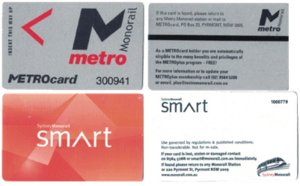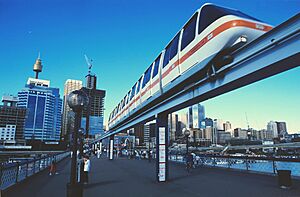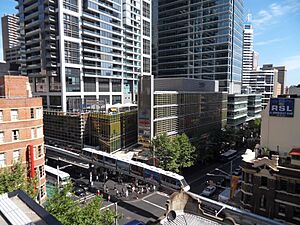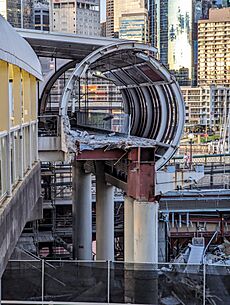Sydney Monorail facts for kids
Quick facts for kids Sydney Monorail |
|
|---|---|
 |
|
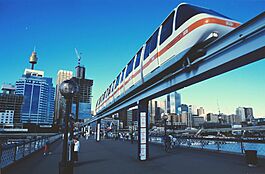
The monorail crossing Pyrmont Bridge (1990)
|
|
| Overview | |
| Status | Dismantled |
| Owner | Metro Transport Sydney |
| Locale | Sydney |
| Stations | 8 |
| Service | |
| Type | Straddle-beam Monorail loop |
| Operator(s) | Veolia Transport Sydney |
| Rolling stock | Von Roll Mk III |
| History | |
| Opened | 21 July 1988 |
| Closed | 30 June 2013 |
| Technical | |
| Line length | 3.6 km (2.2 mi) |
| Electrification | 500 V AC third rail |
The Sydney Monorail was a special train system in Sydney, Australia. It was also known as TNT Harbourlink and later Metro Monorail. This monorail had a single loop track that connected popular places like Darling Harbour, Chinatown, and the main shopping areas in Sydney's city centre.
It started running in July 1988 and closed in June 2013. The track was about 3.6 kilometers (2.2 miles) long. There were eight stations, and up to six trains could run at the same time. The monorail helped people get to major attractions like the Powerhouse Museum, Sydney Aquarium, and the Sydney Convention & Exhibition Centre. The company that operated the monorail was called Veolia Transport Sydney.
Contents
History of the Sydney Monorail
When the Darling Harbour area was being redeveloped, people wanted a way to connect it to Sydney's city centre. The local council thought a light rail system would be best. However, in November 1985, the Transport Minister, Laurie Brereton, announced that a monorail would be built instead.
The monorail was built in just 26 months. It opened on July 21, 1988. The first test runs happened in October 1987 on a small part of the track in Darling Harbour. The company TNT Harbourlink was given permission to run the monorail until 2038.
The monorail was supposed to run from 6 AM to midnight. But after two years, not as many people were using it as expected. Because of this, some planned stations were not built for a while.
Who Owned the Monorail?
In 1998, the original owner, TNT, decided to sell the monorail. This was because they wanted to focus on their mail and logistics businesses. On August 10, 1998, TNT sold the monorail to a group of companies. The main owner was CGEA Transport (which later changed its name to Veolia Transport Sydney).
This group of companies also owned the Sydney Light Rail. Eventually, the monorail and light rail companies combined to form Metro Transport Sydney. In 2011, Veolia Transport joined with another company called Transdev. So, Veolia Transport Sydney became part of the larger Transdev group.
How to Pay for Monorail Rides
To ride the monorail, you could buy tokens and put them into a turnstile for a single trip. If you wanted to ride many times, you could buy special pre-paid cards.
The first card was called the Harbourlink card, launched by TNT. Later, when Metro Transport Sydney took over, they introduced a new card called the METROCard. This card used magnetic stripe technology. Just before the monorail closed, a new contactless card called smart was introduced.
How the Monorail Worked
The monorail track was made of a strong steel box. It was 94 centimeters (37 inches) wide. The track was raised at least 5.5 meters (18 feet) above the ground. It rested on steel columns that were 20 to 40 meters (65 to 130 feet) apart.
The trains got their power from a 500-volt AC (alternating current) supply. This power came from a special conductor located under the track. There was also a control rail to help guide the trains. A backup generator was available to move trains in emergencies.
Each stop at a station took about 40 seconds. This included slowing down, letting passengers on and off, and speeding up again. A full trip around the entire loop took 12 minutes. The system was meant to run automatically at first. However, after some problems when it opened, they decided to keep drivers in the first car of each train.
Monorail Trains
The monorail trains were built by a company called Von Roll Holding in 1987. There were six trains, and each train had seven carriages. Each carriage could seat 48 passengers. The driver sat in the first carriage.
The monorail trains used rubber wheels to run on the track. Each seven-car train had six electric motors. These motors allowed the trains to travel at a normal speed of 33 kilometers per hour (20 miles per hour). The doors on each car opened automatically. The floor level of the cars could also adjust itself using an automatic suspension system. Each train was about 32.12 meters (105 feet) long, 2.06 meters (6.7 feet) wide, and 2.6 meters (8.5 feet) high.
One train (Set 1) was stored after it crashed with another train (Set 4) in 2010. A carriage from Set 1 was used to fix the damaged Set 4. When the monorail closed in June 2013, trains 2 through 6 were still working.
Monorail Stations
The monorail ran in a single loop, always going in an anti-clockwise direction. Here are the stations it stopped at:
| Name | Image | Notes |
|---|---|---|
| City Centre | 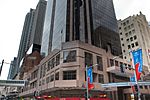 |
A temporary station was used until 1989 while the City Centre Shopping Arcade was being built. |
| Darling Park | 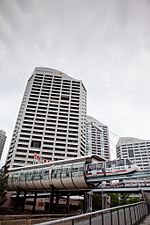 |
This station was originally going to be named Casino. |
| Harbourside | 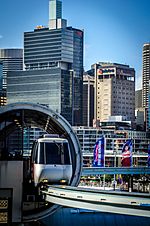 |
This station was next to the Harbourside Shopping Centre. It was taken down in June 2023. |
| Convention | 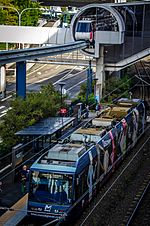 |
This station served the Sydney Convention & Exhibition Centre. |
| Exhibition | There was also a station here in the 1990s and early 2000s. | |
| Paddy's Markets | 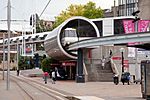 |
This station was once called Powerhouse Museum, and before that, Haymarket. |
| Chinatown | 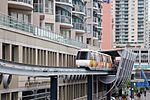 |
This station opened in 2001 as Garden Plaza. It closed in 2004 and reopened as Chinatown in 2006. By 2012, it was only open for a few hours on weekdays. |
| World Square |  |
A temporary station was used here until 2005. Then, a new station was built as part of a nearby building. |
| The Galeries Victoria |  |
This station was first named Park Plaza. A temporary entrance was used until 2000. Now, part of the old station is a gym. |
Maintenance and Control
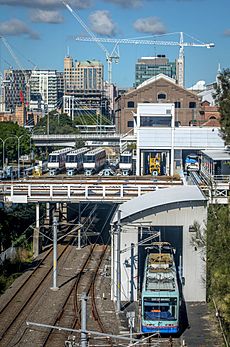
The six monorail trains were kept and repaired in a special building in Pyrmont. A special moving platform, called a traverser, helped move the monorail cars off the main track for repairs or storage. Workers also maintained the track and stations at night using two special vehicles called "Buggy" and "Mule."
The building also had the control room, which was above the maintenance area. This is where staff managed the monorail system.
Why the Monorail Was Criticized
Many people thought that building the monorail instead of a light rail system was a political choice. A light rail system would have been cheaper to build and could carry more passengers. It also would have cost less for a ticket. Sydney used to have a tram system that ran from 1861 to 1961.
Monorail Incidents
The monorail had a few incidents during its time:
- On July 28, 1988, an electrical problem stopped the system. Fifty passengers were stuck in the trains for two hours. The monorail company was criticized for not calling emergency services sooner.
- In July 1992, monorail services stopped because of a fire in a nearby building. A wall collapsed very close to the monorail's control room.
- On February 27, 2010, two monorail trains crashed at Darling Park station. Four people had to go to the hospital.
- On September 24, 2012, a power failure caused the system to shut down completely. About 100 passengers were stuck and had to be rescued using cherry-picker cranes. This rescue took several hours.
Taking Down the Monorail
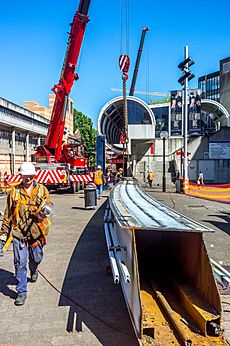
In July 2013, a plan was released for taking down the monorail. On March 23, 2012, the Premier (the leader of the state government), Barry O'Farrell, said that removing the monorail was good for Sydney. He explained that the monorail was not connected to Sydney's other public transport. He also said that the community had "never truly embraced" it. The monorail was also getting old, and the government didn't want to pay for expensive upgrades like new trains.
Taking down the monorail helped clear the way for building a new convention and exhibition centre in Darling Harbour. The monorail was taken down in 2013. Some of its steel beams were recycled and used to build a temporary bridge for a new train station.
After the monorail was removed, 22 carriages were put up for sale online for $3,000 each in January 2015. Some were sold to a person living in Taiwan. Two carriages were bought by Google to be used as meeting rooms in their office in Pyrmont.
Preserving the Monorail
Some parts of the monorail trains have been saved. Eleven carriages from three different trains have been preserved. Two carriages have even been changed into other things.
| Monorail Cars | ||||||||
|---|---|---|---|---|---|---|---|---|
| Set # | Cars preserved | Organisation | Location | Status | Ref | |||
| 2 | 1+3 | National Transport Museum | Inverell | static display | ||||
| 3 | 1+2 | Powerhouse Museum | Ultimo | stored | ||||
| 6+7 | Pyrmont | office meeting room | ||||||
| 4 | Full set | Sydney Electric Train Society | Sydney | future powered display | ||||
The Monorail in Pop Culture
The Sydney Monorail appeared in several movies and songs:
- It was used in scenes for The Saint: Fear in Fun Park and Mighty Morphin Power Rangers: The Movie. For the Power Rangers movie, one train even had "Angel Grove" painted on it.
- It was briefly shown in the 1996 Australian film Napoleon and the 1999 Australian film Two Hands.
- The monorail is in the song "Riding My Train" from the Muppets video Muppets on Wheels.
- It also appears in the song Jaane Kyon from the 2001 Bollywood movie Dil Chahta Hai.
The writer Clive James joked about the monorail in 1991. He said it ran "from the middle of downtown Sydney, to the middle of downtown Sydney, after circumnavigating the middle of downtown Sydney."
Images for kids
See also
 In Spanish: Metro Monorail para niños
In Spanish: Metro Monorail para niños


